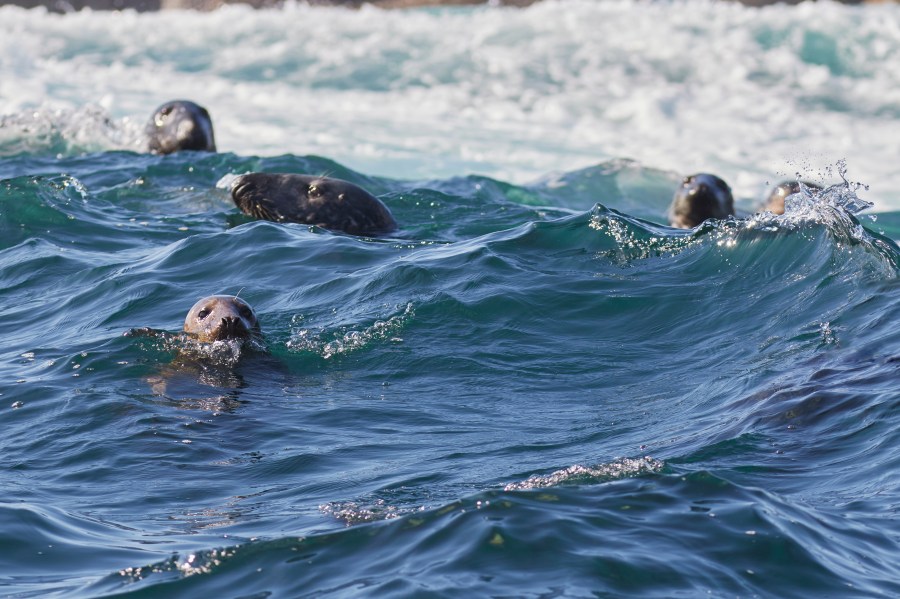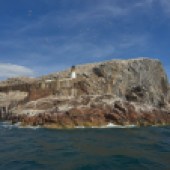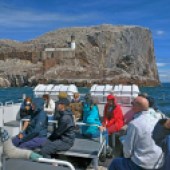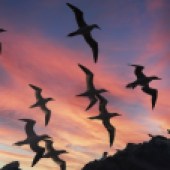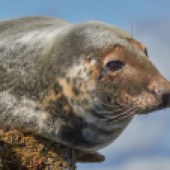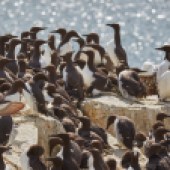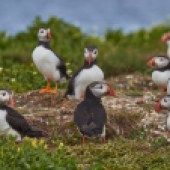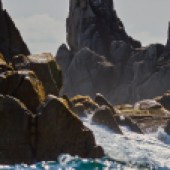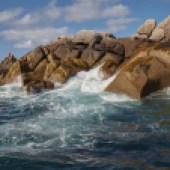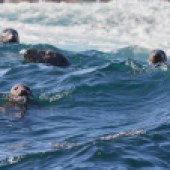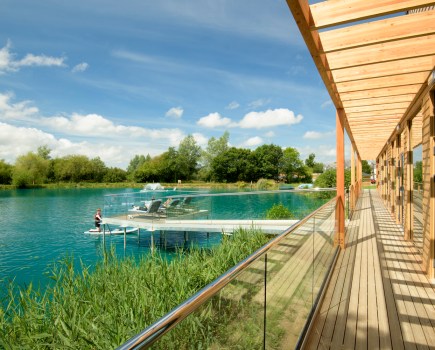Although there is much coastal wildlife along our shores, finding it can be tricky. Here, NIGEL HICKS describes just a few of his favourite sites for spotting marine wildlife.
It can sometimes be rather hard to believe claims that the UK’s coast is a rich haven for marine coastal wildlife. After all, a typical summer’s walk along the cliffs is likely to yield sightings of just a handful of gulls, a smattering of crows, and – if you’re really lucky – one or two seals. Hardly a raging wildlife stampede.
So where is all that coastal wildlife? The answer is that much of it is concentrated into pockets, specific sites scattered around our shores. What’s more, those sites may not be filled with wildlife the whole year round, but only at specific times, mainly the breeding season. So you just have to know where to go, and when.
As a nature photographer, it is part of my work to find these places, putting myself in the right place at the right time. Here, I’m going to highlight just five reasonably accessible sites. There are many more, but this is a useful opener to whet the appetite.
In working from south to north, first up on my list of go-to marine coastal wildlife sites is the Isles of Scilly. Only five of the Scillies’ islands are human-inhabited, with literally hundreds of islands, islets and rocks left to nature.
The main marine wildlife concentrations can be found on the island of Annet and in the Western and the Norrard Rocks, all three lying on the westernmost edge of the Scillies and exposed to the full force of the rolling Atlantic.
A boat trip out to these places in May and June will almost certainly yield sightings of the charismatic puffin, as well as guillemots, razorbills, shags and fulmars, to name just the most obvious. Highly endangered shearwaters can also be sometimes seen, most especially at dusk.
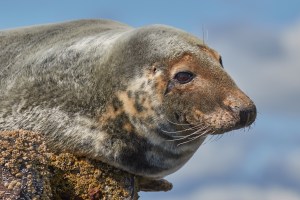
Grey seals can generally be seen throughout the Scillies, but the Western Rocks are their stronghold, large numbers regularly found sunning themselves on rocks, or bobbing around in some of the less exposed waters.
Moving northwards we come to Poole Harbour, a vast natural harbour with just a narrow outlet to the sea. Much of the harbour’s northern and eastern shores are highly urbanised, but the western coast and several islands are rural and quite secluded, forming some wonderful coastal wildlife habitats.
Most famous of these is National Trust-owned Brownsea Island. Much of the island is densely wooded, but along its southeastern shore stretches a tidal salt marsh that in spring and early summer is home to nesting common and sandwich terns, and which in winter is taken over by a host of over-wintering ducks, geese and wading birds. The last of these includes such UK rarities as the Eurasian spoonbill and the great white egret, both of which are slowly establishing themselves in the UK, and for whom Poole Harbour is an important foothold.
Over on the harbour’s western shores a multitude of barely accessible marshes and coves are undoubtedly home to a plethora of over-wintering waders. These are most easily seen at the RSPB’s Arne Nature Reserve, where a shoreline hide regularly gives winter views of both spoonbills and ospreys.
Moving much further northwards we come to Bempton Cliffs, another RSPB reserve, this one sitting between the tourism centres of Scarborough and Bridlington. The natural ledges cut into the otherwise sheer chalk cliffs here provide ideal nesting sites for tens of thousands of marine birds, most especially the iconic and unmistakable northern gannet.
Numbering roughly 30,000, this is one of Europe’s largest gannet colonies, and the only one on the UK mainland: all the others are found on islands around our shores. The UK’s largest marine bird, gannets crowd onto Bempton’s cliffs from roughly April through to October, making quite a spectacular sight for coastal wildlife.
The gannets aren’t alone here, of course, sharing the cliffs with colonies of kittiwakes, razorbills, guillemots and a relatively small number of puffins, but the gannets stay here the longest. All the other birds are gone by mid-July, leaving the cliffs almost entirely to the gannets.
The reserve can be explored both on foot and by boat, the former giving many very good close views of the colonies, thanks to some well-built cliff-edge viewing platforms. Boat trips out of Bridlington give great views from below, as well as of birds on the water. They also provide – if you’re lucky – meetings with dolphins along the route between harbour and cliffs.
Travelling further north, into Northumberland, we reach the National Trust-owned Farne Islands. A cluster of small, low-lying islands a short distance from the fishing village of Seahouses, during the spring and early summer this is one huge marine avian metropolis. Most of the islands are completely off-limits during the breeding season, but two – Inner Farne and Staple Island – are open to controlled numbers of visitors for a few hours each day.
Looking for a wildlife watching adventure? Check out the 5 best beaches for watching wildlife.
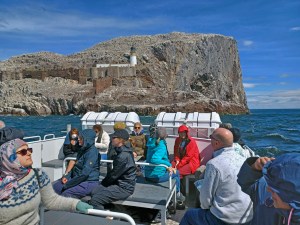
A limited number of boat trips first take you out to the furthest of the islands, Longstone, where grey seals can usually be seen, before coming back to Staple Island for a couple of hours, and then finally to Inner Farne. Staple Island is renowned for its teeming colonies of guillemots, razorbills and kittiwakes, plus its charismatic puffins, along with clusters of shags.
The prize attraction on Inner Farne is the large colony of arctic terns, one of the largest in the UK. These noisy, aggressive birds nest in areas of long grass across much of the island, while – as with Staple – the rocky cliffs are the preserve of the usual guillemots, razorbills, kittiwakes and shags.
One of the great features of these islands is that it’s possible to wander among the birds, walking barely a few feet away from their nests. Although this provides a fantastic experience, it doesn’t come without risk: wander too close and you’re likely to have an irate parent on your hands. The worst for this are the Arctic terns, infamous for continuously diving onto visitors who dare to come anywhere near a colony. Watch out. These guys mean business!
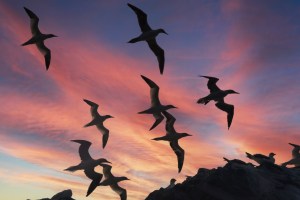
The final site on my little tour is the magnificent Bass Rock, a huge outcrop sitting in the Firth of Forth, a few miles east of the harbour at North Berwick. This rock is one vast northern gannet metropolis, and with an estimated 150,000 birds it is thought to house Europe’s largest breeding colony. Even in grey weather this lonely rock glistens white, partly a result of the nature of its rock, but largely simply due to the sheer numbers of birds and the guano that cover it.
Boat trips visit the rock from North Berwick, most of them simply circling around the rock, with just the occasional boat landing. Those visitors that are lucky enough to land will be confronted by a steep cliff path that works its way up the rock towards what used to be a prison. The huge plus is that you get to have the privilege of walking among thousands of gannets. This is another place where the boat ride between site and harbour might provide dolphin encounters, but as usual this is very hit and miss.
This is just a brief introduction to a few of the great marine wildlife sites that lie around our coasts though of course there are many more that are worth visiting. They are usually not too difficult to research to help you find a few closest to you.
HOW TO PHOTOGRAPH MARINE WILDLIFE
Good photography of marine wildlife almost always entails use of strong telephoto lenses coupled with mirrorless or DSLR cameras. Subjects are usually some distance away, with close-up experiences the rare exception. Still, wide-angle lenses can sometimes be useful when it comes to photographing general views of breeding colonies.
Photographing a stationary bird with a telephoto lens is generally not too difficult, though shooting one in flight is quite another story. For this a steady hand, quick reflexes and a very fast shutter speed are needed. One advantage of a telephoto lens – quite apart from being able to make the distant subject appear a lot closer – is that the background will go out of focus, ensuring that your subject really stands out.
Needless to say, using a big lens is a whole lot easier when standing on firm land than it is from a rolling boat. If you’re having to do the latter, make sure you’ve got your sea sickness pills to hand!

